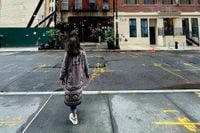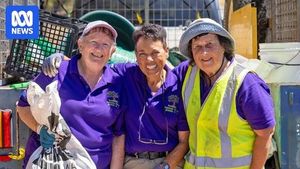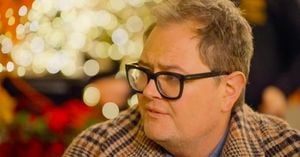Smoke curled up from a subway grate in Lower Manhattan as the city bustled on, but beneath the surface of the Financial District’s relentless pace, stories lingered—some fiercely debated, others nearly vanished. In 2025, as New York City prepared to mark its 400th birthday, two distinct yet intertwined narratives unfolded: the passionate, sometimes pedantic world of Wikipedia’s New York editors, and the poignant remembrance of Little Syria, a once-thriving Arab immigrant enclave now almost erased from the city’s map.
In May, a Mexican Navy training ship struck the Brooklyn Bridge. What might have been a simple news item instead sparked a months-long debate among more than two dozen Wikipedia editors. Was it a "collision" or an "allision"? In the world of maritime terminology, the difference matters: a collision involves two moving objects, while an allision is when a moving object hits something stationary. “Yes, it's an allision,” insisted one editor on Wikipedia’s talk pages, while another countered, “That's not a reason to use the terminology incorrectly, which degrades the public's use of language.” The debate, as reported by The City, raged until late July, when consensus settled—at least for now—on the "Cuauhtémoc–Brooklyn Bridge collision."
This might sound like internet pedantry at its finest, but for New York’s Wikipedia community, such debates are driven by a passion for accuracy and a commitment to representing the city’s story with care. It’s a community that thrives on collaboration—both online and in person. As Annie Rauwerda, a prolific editor and creator of the Depths of Wikipedia social media accounts, put it, “Basically, there's all these people that I would have expected to stay on different sides of the room, because they just disagree constantly about certain things.” Yet, she explained, at in-person events hosted by Wikimedia New York City—a volunteer nonprofit that connects people with Wikipedia and the broader free culture movement—editors are more “buddy-buddy” than adversarial. “There’s something so social and welcoming about it that I don’t feel every single time I’m in a group of Wikipedia editors.”
This spirit of collaboration will be on full display from October 16 to 19, when Civic Hall in Union Square hosts the annual WikiConference North America. The event, one of the largest gatherings in the wiki-world, will feature lectures, edit-a-thons, and discussions on everything from fighting disinformation to expanding Wikipedia’s reach into virtual spaces like Roblox. Among the highlights: a Q&A session with Wikipedia’s Arbitration Committee, the group responsible for settling especially serious disputes. According to Wikimedia NYC executive director Pacita Rudder, “When there are disagreements, it’s open.” She encourages newcomers to attend the recurring events, emphasizing that “trying to learn the platform on your own at home can be really hard, especially when it's your first time.”
This year’s conference will also pay homage to the city’s 400th birthday—a milestone that, in true Wikipedia fashion, is itself subject to debate. While 2025 marks four centuries since the Dutch founded Fort Amsterdam, Indigenous communities lived here long before, and not every record is clear-cut. Wikimedia NYC’s NYC400 campaign, inviting nominations for 400 people and places that deserve Wikipedia pages, acknowledges the city’s layered and contested history.
That history is nowhere more poignant than in the story of Little Syria, a neighborhood that once thrived just south of today’s World Trade Center. As The Independent reported on September 28, 2025, Little Syria was home to approximately 95,000 Arab immigrants who arrived during the Great Migration from 1880 to 1924. Drawn by jobs near the docks, they built a vibrant community of Arabic shops, bakeries, bookshops, and even newspapers—thanks in part to the early adaptation of the linotype machine for Arabic script.
Elizabeth H. Berger Plaza now stands as a quiet patch of green in the Financial District, dotted with benches dedicated to members of the Pen League, a collective of Syrian and Lebanese writers formed in 1920. The plaza’s commemorative signs recall a time when the area echoed with shisha and baklava, rather than the hum of Wall Street. But tangible traces of Little Syria are scarce. Only three buildings remain: St George’s Syrian Catholic Church, built in 1812 and granted landmark status in 2009; the Downtown Community House, built in 1926 as a settlement space for new immigrants; and a tenement at 109 Washington Street, dating to 1885 and still home to rent-controlled tenants. The ground floor, once a hub for shops and social gatherings, now houses a restaurant and bar.
The neighborhood’s erasure began after the Immigration Act of 1924, which imposed strict quotas and outright bans on immigrants from many countries, including Arab nations. The subsequent construction of the Brooklyn-Battery Tunnel in the 1940s and the later expansion of the World Trade Center complex accelerated the disappearance. Today, the spire of One World Trade Center looms over the last vestiges of Little Syria—a stark reminder of both progress and loss.
St George’s Syrian Catholic Church, also known as St George’s Chapel, stands beside the world’s tallest Holiday Inn at 103 Washington Street. Deconsecrated for decades, it served as an Irish tavern and later a Chinese restaurant. Its distinctive terracotta facade and layered history reflect the neighborhood’s evolution: from a place of worship to a boarding house for immigrants, then a commercial space. Next door, the Downtown Community House and the tenement at 109 Washington Street represent the last physical links to a community that once filled the area with life, commerce, and culture.
Little Syria was not only home to Christians. In 2015, historians discovered that a mosque once stood on Rector Street, serving the area’s Muslim residents during the neighborhood’s heyday. The mosque was demolished in the 1950s, but its memory endures as evidence of the longstanding and diverse Middle Eastern presence in the United States.
Preservationists from the Washington Street Historical Society continue to push for protection of the remaining buildings, but only the church is currently landmarked. The uncertain fate of the tenement and community house underscores how easily entire histories can vanish when neighborhoods are erased by urban development and shifting priorities. As The Independent noted, “The tragedy of Little Syria is that so much of this evolution was forced upon the neighborhood by the construction of skyscrapers as New York cemented itself as the world’s most important city, and by the Brooklyn-Battery Tunnel as successive city planners gave the metropolis’s landscape over to cars rather than people.”
Meanwhile, Wikipedia’s New York community continues its mission to document, debate, and preserve the city’s stories—whether through spirited arguments over maritime terminology or through painstaking research into overlooked chapters like Little Syria. Editors like Ryan Ng, known as “Epicgenius,” exemplify this dedication. Ng, who began attending in-person events around 2018, has contributed to countless articles about New York’s architecture and transportation. He’s no stranger to the site’s sometimes heated “edit wars,” but he’s found that, in the end, collaboration and openness win out.
As New York celebrates 400 years, the city’s Wikipedia editors and preservationists alike remind us that history is not static. It’s a living, contested, and ever-evolving narrative—one that depends on the passion of volunteers, the vigilance of communities, and a willingness to remember what might otherwise be forgotten.




